Preprint
Article
A Geometrical Study about the Biparametric Family of Anomalies in the Elliptic Two Body Problem with Extensions to Other Families
Altmetrics
Downloads
63
Views
17
Comments
0
A peer-reviewed article of this preprint also exists.
This version is not peer-reviewed
Submitted:
29 January 2024
Posted:
30 January 2024
You are already at the latest version
Alerts
Abstract
In the present paper, we efficiently solve the two-body problem for extreme cases such as those with high eccentricities. The use of numerical methods, with the usual variables, cannot maintain the perihelion passage accurately. In previous articles, we have verified that this problem is treated more adequately through temporal reparametrizations related to the mean anomaly through the partition function. The biparametric family of anomalies, with an appropriate partition function, allows a systematic study of these transformations. In the present work, we consider the elliptical orbit as a meridian section of the ellipsoid of revolution, and the partition function depends on two variables raised to specific parameters. One of the variables is the mean radius of the ellipsoid at the secondary, and the other is the distance to the primary. One parameter regulates the concentration of points in the apoapsis region, and the other produces a symmetrical displacement between the polar and equatorial regions. The three most used geodesy latitude variables are also studied, resulting in one not belonging to the biparametric family. However, it is in the one introduced now, which implies an extension of the biparametric method. The results obtained by the method presented here now allow a causal interpretation of the operation of numerous reparametrizations used in the study of orbital motion.
Keywords:
Subject: Computer Science and Mathematics - Applied Mathematics
1. Introduction
One of the main problems in celestial mechanics is the two-body problem, especially in its elliptical case. This problem can be formulated as: given two masses , called primary and secondary respectively, establish the position of the secondary relative to the primary denoted by as a function of time.
The second-order differential equations define the relative motion of the secondary with respect to the primary:
where is the vector radius of the secondary and where G is the gravitational constant and , the masses of the primary and the secondary respectively.
The two-body problem in celestial mechanics is a well-known classical problem is an integrable problem whose analytical solution is well known. It has been studied by numerous authors e.g. [1,9,12,13,22].
This problem is also appropriate for testing numerical methods because we can compare the numerical and the analytical solutions. The analytical solution is described by the set III of elements of Brouwer and Clemence [1].
The performance of the numerical methods is good. However, the distribution of points provided by the natural time is contrary to the dynamics by accumulating more points in the apoapsis region than in the periapsis region if constant time intervals are taken as base points of integration when the opposite would be desirable. One way to achieve this goal is to find a temporal variable for which the distribution of points at constant intervals in the new variables is more significant in the areas of higher speed of the secondary and those with greater curvature. This is particularly interesting in the case of very high eccentricities, like most periodic comets, in whose study numerical integrators can and do present problems.
There are several ways to solve this problem. In this paper, we use the analytical regularization of stepsize to reparametrize the orbit to get a more appropriate point distribution on the orbit. This method can be combined with variable stepsize integrators, symplectic integrators, and other techniques. The reparametrization technique is a very interesting method to solve several problems. A review of these methods can be seen in [4].
In 1912, Sundman [21] introduced a change of temporal variable using the transformation , a temporal reparametri- zation of the motion known as the Sundman transformation. In this transformation, we can change the time by the mean anomaly multiplying by the mean motion n and including in a normalization factor the Sundman transformation can be rewritten as where g is the eccentric anomaly. To solve this problem, several authors try to use a time transformation to obtain a point distribution more according to the dynamics.
- Hansen [19] was a pioneer in this field introducing the relative anomalies.
- Nacozy [20] introduced a new anomaly related by
- Brumberg [2] introduced the regularized length of arc by , where v is the velocity of the secondary.
- Brumberg and Fukushima [3] introduced the elliptic anomaly w as , where .
This method has been used by several authors obtaining a set of time reparametrizations in the form where is called partition function and is a periodic function of M which satisfies , . In this sense, Nacozy introduced a new parameter related by [20], Janin and Bond extended this transformation to defined by [10,11], Brumberg [2] introduced the regularized length of arc by , where v is the velocity of the secondary, Brumberg and Fukushima introduced the elliptic anomaly w as , where [3].
All these variables can be reduced to anomalies, including a normalization scale factor so that they take values in along one revolution, The classic mean anomaly M, the eccentric anomaly g, and the true anomaly f can be considered temporal variables. López [18] defines the semifocal anomaly as the mean between f and , where is the antifocal anomaly [8].
In the year 2017, Lopez introduced the biparametic family of anomalies defined by López [16] as
This family contains the anomalies defined by the previous time transformations. For we have the mean anomaly M, for , , the eccentric anomaly g, for , the generalized length of arc introduced by Brumberg, for , the elliptic anomaly w for , the antifocal anomaly, and for , the semifocal anomaly.
Notice that the anomaly is symmetric to the axis of the ellipse when .
This paper is focused on studying a new geometric point of view about the biparamétric family. This section presents the background and the primary goal of this paper. In Section 2, we study the relation between the curvature of the revolution ellipsoid that contains the orbit and the vector radii r. From them, the biparametric family of anomalies is related through the vector radius r and the mean radius of curvature of the ellipsoid. In section 3, we study several anomalies induced by the latitudes of the ellipsoid, in particular, the geodetic latitude and the geocentric latitude , concluding in the first case that the anomaly induced by the geodetic latitude coincides with the semifocal anomaly and the anomaly induced by the geocentric anomaly is not included in the biparametric family of anomalies. Despite the above, we can generalize the relations obtained for the biparametric family in some instances to the other anomalies. In section 5, we present several numerical examples which allow a better understanding of the results previously obtained. In section 6, the main conclusions of this study will be discussed.
2. The biparametric family of anomalies as function of vector radius and the curvature.
This section studies the relationship between the product of the radii vectors r and of a point P, which represents the secondary point in the elliptic case of the two-body problem, where r represents the distance to the main focus where the primary is located and the distance to the secondary focus of the ellipse, these magnitudes are reflected in Figure 1 where the true anomaly also appears f and the antifocal anomaly . The radii vectors r, , since the orbit is an ellipse, are related by
Taking into account the relationship between the radius vector as a function of the eccentric anomaly in the two-body problem and (3), we immediately have:
In order to find simple geometric relationships, we will generate an ellipsoid of revolution from the ellipse by rotating the orbit around its semi-minor axis. In this ellipsoid, we will take the meridian of zero longitude as the one containing the periapsis of the orbit. It is enough to obtain its longitude and latitude to determine the position of a point P on the ellipsoid. In the case of points located on the orbit whose rotation generates the ellipsoid and the origin of its length is fixed, it is more convenient to dispense with the length and take a modified length that takes values between , which does not present any difficulty and characterizes all the points P of the orbit.
Figure 2 shows the variables u, and [13,23] called in geodesy as parametric or reduced latitude, geodesic latitude, and geocentric latitude. When we restrict ourselves to the orbit generated by the ellipsoid, as stated above, we will call them eccentric anomaly g in the case of u, geodesic anomaly in the case of , and geocentric anomaly in the case of . In the next section, it will be shown that the geodetic anomaly coincides with the semifocal anomaly in elliptical motion.
To study the main curvature and the mean and Gaussian curvature, for reasons of symmetry, it will be enough to do it in the first quadrant of the ellipse. Firstly, given a non-umbilical point P[6] on the first quadrant we will consider a coordinate system so that O is located in the center of the orbit and therefore of the elpsoid, the axis (running to the peripsis), the axis in the direction of the semi-minor axis of the ellipse and the axis forming a direct trihedron with O and . This notation, which is different from that used in geodesy, is used in celestial mechanics when we take the orbital plane as the plane and place O in the center of the orbit.
In the ellipse that defines the equation of the orbit, the main directions of curvature are given by the direction of the meridian and that of the parallel. In the first case, the ellipse itself is normal to the surface of the ellipse, its curvature will be the main curvature and the corresponding radius, which we will denote by , is given by [13,23]:
On the other hand, the parallel is not a normal section of the ellipsoid. To construct the corresponding normal section, the first vertical must intersect with the ellipsoid, and from their curvatures [13,23], it turns out that:
For a normal section whose direction in P has azimuth A measured from the north it is verified that its curvature and its radius of curvature are given [23] by:
It is also of interest the calculation of the average curvature and the average radius of curvature leads to the quantities [23]
If, in addition, we average the radii of normal curvatures following directions of different azimuths A at a point P [23], we have that:
Notice that the relation is not satisfied. For this reason and to avoid confusion, we will use the notation since, as we have seen, it is not the inverse of the mean curvature.
Taking into consideration the Gaussian curvature of a surface which is an intrinsic magnitude, a result known as Gauss’s theorem egregium [6], we have that and, therefore, defining as:
it is verified that:
To obtain the mean radius of curvature R, as a function of the geodetic latitude, just replace (6), (7) in (10) from which we get:
On the other hand, as will be seen in the next section, the geodetic latitude coincides with the semifocal anomaly, and therefore, the sine of the latitude is expressed as a function of the eccentric anomaly g [18] as:
Finally, we obtain that the product of the radius vectors r and given by (4) is given by:
comparing this last expression with (15), we get the fundamental relation:
Given an anomaly in the biparametric family (2) , we can define an equivalent anomaly whose relationship to the mean anomaly is given by:
where , , .
In this way, we have the anomaly but whose connection with the average anomaly is given by (18) where a normalization constant appears. The radius vector r raised to an exponent times the average radius of curvature of the ellipsoid of revolution that contains the orbit as a meridian ellipse R raised to . This fact is of great importance because of the effect that the factor causes when we work with a constant step number, namely a translation of the points from the apoapsis region, in the case of working with M, to more concentrated points in the periapsis region, that it is more remarkable as increases. In the case of we are faced with a symmetrical anomaly with respect to the axes of the orbital ellipse.
The second factor transfers a set of points symmetrical to the axes of the orbital ellipse towards the intersections of the ellipse with the semimajor axis a, if is positive and towards the intersection of the ellipse with its semi-minor axis, if is negative.
As the numerical examples section shows, this fact allows for a purely geometric explanation in the biparametric family of anomalies.
3. Other symmetric variables not belonging to the biparametric family
This section shows that some symmetric variables cannot be included in the modified biparametric family defined above. First, the study of three temporal variables related to the latitudes used in geodesy is addressed to do this. We will consider an ellipsoid of revolution around the semi-minor axis of the ellipse so that the orbit is the meridian ellipse located so that the length of the periapsis is zero. The position of a point P on the orbit is determined by the position of this point on the ellipsoid, so it will be enough to determine its latitude on the ellipsoid. In geodesy, the use of three latitudes is common. These latitudes are reflected in Figure 1: the reduced or parametric latitude u, the geodesic latitude , and the geocentric latitude .
The reduced latitude u is better known as an eccentric anomaly g in celestial mechanics. The geodesic latitude coincides with the semifocal latitude defined by the authors since a characteristic of the ellipse is the so-called property of elliptical billiards, according to which a ball located at the primary focus, once thrown bounces off the ellipse and heads to the secondary focus. Therefore, if we consider the point N intersection of the bisector of the angle formed by the radii vectors and in P it results that on the one hand Figure 3, in the triangle of vertices we have that , and in the triangle of vertices is verified from which, eliminating , we have . The third latitude variable is the geocentric latitude , which gives rise to a new symmetric anomaly that we will call the central anomaly. Since the radii r, are, according to the property of elliptical billiards, reflected from each other in the ellipse, the direction is normal to the ellipse and therefore coincides with the geodetic latitude.
On the other hand, as is well known, the coordinates of the secondary with respect to the primary are given as:
and the distances between the primary and secondary foci by (4).
The eccentric anomaly has been well studied by many classical authors [1,9,22] among others. The semifocal anomaly that, for the reasons explained above, we will also call geodesic anomaly has also been studied by [17,18]. At this point, it remains to study the central anomaly . To do this, let be the distance , which is determined by the coordinates of the point P with respect to the system of axes with origin in O. Thus, we have:
Depending on the eccentric anomaly, we have , for this, let be the distance , which is determined by the coordinates of the point P with respect to the axis system with origin in O; thus, we have:
where a, are the semimajor and semiminor axes of the ellipse. From the previous equation we have:
On the other hand, from the equation of the ellipse , is obtained in function of as:
From this equation, and after some elemental calculations, we obtain:
Deriving (26), and after some calculations we have:
and taking into account (22) the relationship is obtained:
and considering Kepler’s equation for the eccentric anomaly:
where M is the mean anomaly. It is obtained by derivation:
Finally, from (30), (28) and (4), we obtain:
where, from (22) and (31) the partition function and after some elemental calculations, we can express as:
It is evident that the central anomaly is not in the biparametric family of anomalies. This is not new since the intermediate radials of Cid [5], the natural family of anomalies [14], and the geometric family of anomalies [15] are not in general in the biparametic family, but they are in the symmetrical case since they coincide respectively with the semifocal anomaly and with the eccentric anomaly. Therefore, we have a symmetrical anomaly that does not belong to the biparametic family.
However, if it is possible to represent it in the form:
from which we have , where is a function of R given by .
This fact can be generalized to reparameterizations:
where the partition function can be written as the product of a power of r times a function of the mean radius of curvature of the ellipsoid of revolution generated by the orbital ellipse. Note that, on the one hand, the normalization factor has been included in the function h and, on the other hand, must be an admissible reparametrization.
As a final consideration in this section, it should be noted that plays the same role as in the case of symmetric anomalies and plays a role similar to that of if Well, in this case there are more types of symmetrical motions of the points with respect to the semi-axes than those given by the term that appears in the case of the biparametric family.
4. Numerical examples
To illustrate the previously obtained results with respect to the new geometric interpretation that transforms the anomaly into its equivalent we will first proceed to represent a set of 20 equally spaced points for this, we will take as an example a satellite with eccentricity as an example M corresponding to , , g corresponding to , , corresponding to , and f corresponding to , .
In Figure 4, it can be seen that the factor causes a displacement of points from the region corresponding to the apoapsis, that is, from the left part of the ellipse to the region of the periapsis, right part of the ellipse. This fact implies a distribution of points more in line with the dynamics, which is reflected in better integration values.
Secondly, if the value of is fixed, we will focus on the example in Figure 5 in the case corresponding to symmetric anomalies. The reason for this choice is to show the action of in a more transparent way.
Also, in Figure 6, twenty uniformly distributed points for the eccentric anomaly and the central anomaly are presented on the same graph, and it can be seen that the big black points are more concentrated towards the periapsis and apoapsis region than those corresponding to the central anomaly. Smaller red dots are more concentrated in the regions corresponding to the intersection of the orbit with respect to the semi-minor axis, so it is expected that for large eccentricities, the central anomaly will provide worse precision in the study of orbital motion than the eccentric anomaly.
To interpret the effect on the errors in numerical integration, we proceed to integrate the old artificial satellite Heos II, which is done in order to compare our results with those of other authors cited above who used this satellite as a test. The satellite’s orbital elements are given by , , , , , . The period of the satellite is days and for the Earth the spaceflight constant . Finally, we will analyze the integration errors for various anomalies in the biparametric family according to the new interpretation based on .
The results obtained are contained in Table 1, which is, in essence, the same Table 1 that appears in [16] corrected, to which the column corresponding to the semifocal anomaly has been added and the one that has been added in the lower part the values corresponding to the respective .
Table 1 shows the errors regarding the position and initial velocity made in the numerical integration using equally spaced points, taking different anomalies as integration variables. If the table with value is observed, the average anomaly M and the antifocal anomaly appear, which are differentiated by the value of , which in the case of the average anomaly takes a value of 0 and in the case of the antifocal anomaly it takes a value of 1. It can be seen in Figure 6 that the distribution of points differs in both cases, concentrating more points in the periapsis region, and correspondingly in the apoapsis region in the case of the antifocal anomaly which is reflected in the results.
In the case of , which corresponds to symmetric anomalies, if the eccentric anomaly g is taken as a basis, the regularized arc length takes the value which moves the points away from the apsidal regions, causing worse results, in the case of the elliptical anomaly w and the semifocal anomaly delta takes values and 1 respectively, in both cases It appears that the precision in position and speed improves with respect to the eccentric anomaly g, which corresponds to a greater concentration of points in the apsidal regions, with the values being better in the case of w. It can be understood that for large values of , too many points have been removed over the region corresponding to the ellipse intersection with its semi-minor axis, causing a certain loss of precision.
5. Concluding Remarks
In the present work, the relationship between the curvature of a point P of the orbit with the main curvatures of an ellipsoid of revolution generated by the rotation of the orbital ellipse around its semi-minor axis has been addressed from a strictly geometric point of view.
Geometric geodesy studies in depth, as a preliminary topic, the geometry of the ellipsoid of revolution, resulting in that at a point P, the directions of the main curvature are given by the curvature of the meridian ellipse that passes through the point and the normal direction of the parallel to the ellipsoid that passes through the given point and, since the parallel is not normal to the surface of the ellipsoid, the second principal curvature is determined by the intersection curve between the first vertical that passes through P and the ellipsoid. The inverses of the principal curvatures determine the radii of the main curvatures and . From these curvatures and given a direction in P of geodesic azimuth A, we have, without further ado than applying classical theory, the curvatures of the normal sections in P, according to the directions corresponding to the different azimuths, as well as the corresponding radii of normal curvature . The expressions for the curvatures and radii of curvature above are somewhat complicated as they contain fractional exponents.
Next, the mean curvature is obtained as an integral mean of the normal curvature with respect to the different azimuths and the average radius of curvature, also as an integral mean and with respect to the different azimuths. The mean curvature and the mean radius of curvature are not inverse, so for simplicity and convenience, R is denoted by the mean radius of curvature whose turns out to be the inverse of the Gaussian curvature , expression in which fractional powers no longer appear in its latitude-dependent part. The calculation of the product of the radius vectors leads to an expression directly proportional to R so that the partition function of the biparametric family of anomalies can be written as where and which appears perfectly factored with respect to the radius vector of the secondary with respect to the primary r and the average radius of curvature of the ellipsoid at the point P.
On the other hand, in geodesy, three latitudes are used: the parametric latitude u, the geodetic latitude , and the geocentric latitude , which can be modified for a meridian ellipse by making its value oscillate between , thus making u coincide with the eccentric anomaly g, the geodetic latitude is shown to coincide with the semifocal anomaly, and the modified geocentric latitude which does not coincide with any of the known anomalies and is defined as a central anomaly. Once a sufficiently complete study of this variable has been carried out, we obtain the relationships between and the eccentric anomaly g in closed form. The parity function that relates the anomaly to the mean anomaly M is also obtained.
One of the first results observed is that said anomaly, which is obviously symmetrical, does not belong to the biparametic family of anomalies. Despite this, it is possible to factorize the partition function as a function proportional to , which allows an interpretation similar to that of the anomalies of the biparametric family, which allows the method to be extended to anomalies whose function of partition is proportional to , provided that they constitute an admissible reparametization of the ellipse.
In the numerical examples section, the effect of and is observed for the case of the biparametric family. The factor causes a translation of the points from the apoapsis region to the periapsis region when a set of equally spaced points is taken in the corresponding anomaly. This translation is more significant the larger is. The factor causes a symmetric distribution of the points with respect to the axes, bringing them closer to the apsidal region when and to the region of the orbit that cuts the semi-minor axis when . Finally, a case of integration over one revolution of a highly eccentric artificial satellite is studied, interpreting the precisions obtained following these guidelines, which is totally coherent.
In this way, a purely geometric interpretation of the biparametric family of anomalies has been obtained, allowing a more straightforward interpretation and being the results completely explainable. As we have seen previously, the result can be extended to other families, although this should be addressed in the future.
Funding
This work has been partially supported by grant 16I358.01/1 of University Jaume I of Castellón.
Conflicts of Interest
The authors declare that they have no conflict of interest with regard to this work.
References
- D. Brouwer, G.M. Clemence, (1961). Methods of Celestial Mechanics. New York. Academic Press.
- Brumberg, E.V. Length of arc as independent argument for highly eccentric orbits, Celestial Mechanics.53, 323–328, 1992. [CrossRef]
- E.V. Brumberg and T. Fufkushima (1994). Expansions of elliptic motion based on elliptic functions theory, Celestial Mechanics and Dynamical Astronomy60, 69–89. [CrossRef]
- Cariñena J F, Martínez E and Muñoz-Lecanda M C. (2022). Infinitesimal time reparametrisation and its applications Journal of Nonlinear Mathematical Physics29 523–55. [CrossRef]
- R. Cid, S. Ferrer, A. Elipe (1983). Regularization and linearization of the equations of motion in central force-fields, Celestial Mechanics31 73–80. [CrossRef]
- P. do Carmo (2017) Differential Geometry of Curves and Surfaces (second edition). Dover Publications Inc.
- J.M. Ferrándiz, S. Ferrer and M.L. Sein-Echaluce (1987). Generalized elliptic anomalies, Celestial Mechanics.40, 315–328. [CrossRef]
- T. Fukushima. (2004). Efficient Orbit Integration by the Orbital Longitude Method Using Antifocal Anomaly.The Astrononical Journal128, 1455–1464. [CrossRef]
- Y. Hagihara, 1970. Celestial Mechanics. Cambridge, MA: MIT Press.
- Janin, G. (1974) Accurate Computation of Highly Eccentric Satellite Orbits, Celestial Mechanics.10, 451–467.
- Janin, G., Bond, V. R. (1980) The elliptic anomaly, NASA Technical Memorandum 58228.
- J. Kovalevsky, (1967). Introduction to Celestial Mechanics, D. Reidel Publishing Company, Dordrecht, Holland.
- L.L Levallois, J. Kovalewsky, (1971). Geodesie Generale Vol 4, Ed Eyrolles, Paris.
- J.A. López, F.J. Marco, M. J. Martínez. (2014). A Study about the Integration of the Elliptical Orbital Motion Based on a Special One-Parametric Family of Anomalies. Abstract and Applied Analysis. Article ID 162060, 1–11.
- J.A. López, F.J. Marco, M. J. Martínez. (2016). Geometrical definition of a continuous family of time transformations generalizing and including the classic anomalies of the elliptic two-body problem. Journal of Computational and Applied Mathematics318, pág 479–490.
- J.A. López, V. Agost, M. Barreda. (2017) A new bi-parametric family of temporal transformations to improve the integration algorithms in the study of the orbital motion. Journal of Computational and Applied Mathematics309, 482–492.
- J.A. López, V. Agost, M. Barreda. (2022) Study of a Set of Symmetric Temporal Transformations for the Study of the Orbital Motion Computationl and Mathematical Methods. Article ID 9037530.
- J.A. López, V. Agost, M. Barreda. (2023). CMMSE: Study of a new symmetric anomaly in the elliptic, hyperbolic, and parabolic Keplerian motion Mathematical Methods in the Applied Sciences46 1429-1442.
- P. Nacozy. 1969. Hansen’s Method of Partial Anomalies: an Application. The Astronomical Journal.74 544–550.
- P.Nacozy. (1977). The intermediate anomaly.Celestial Mechanics16, 309–313.
- K. Sundman, (1912) Memoire sur le probleme des trois corps, Acta Mathematica36, 105–179.
- F.F. Tisserand, (1894). Traité de Mécanique Céleste, Gauthier-Vilars, Paris.
- P.S. Zakatov (1976). A Course in Higher Geodesy. Ed Mir Moscú. Russia.
Figure 1.
True f and antifocal anomaly and vector radii and .
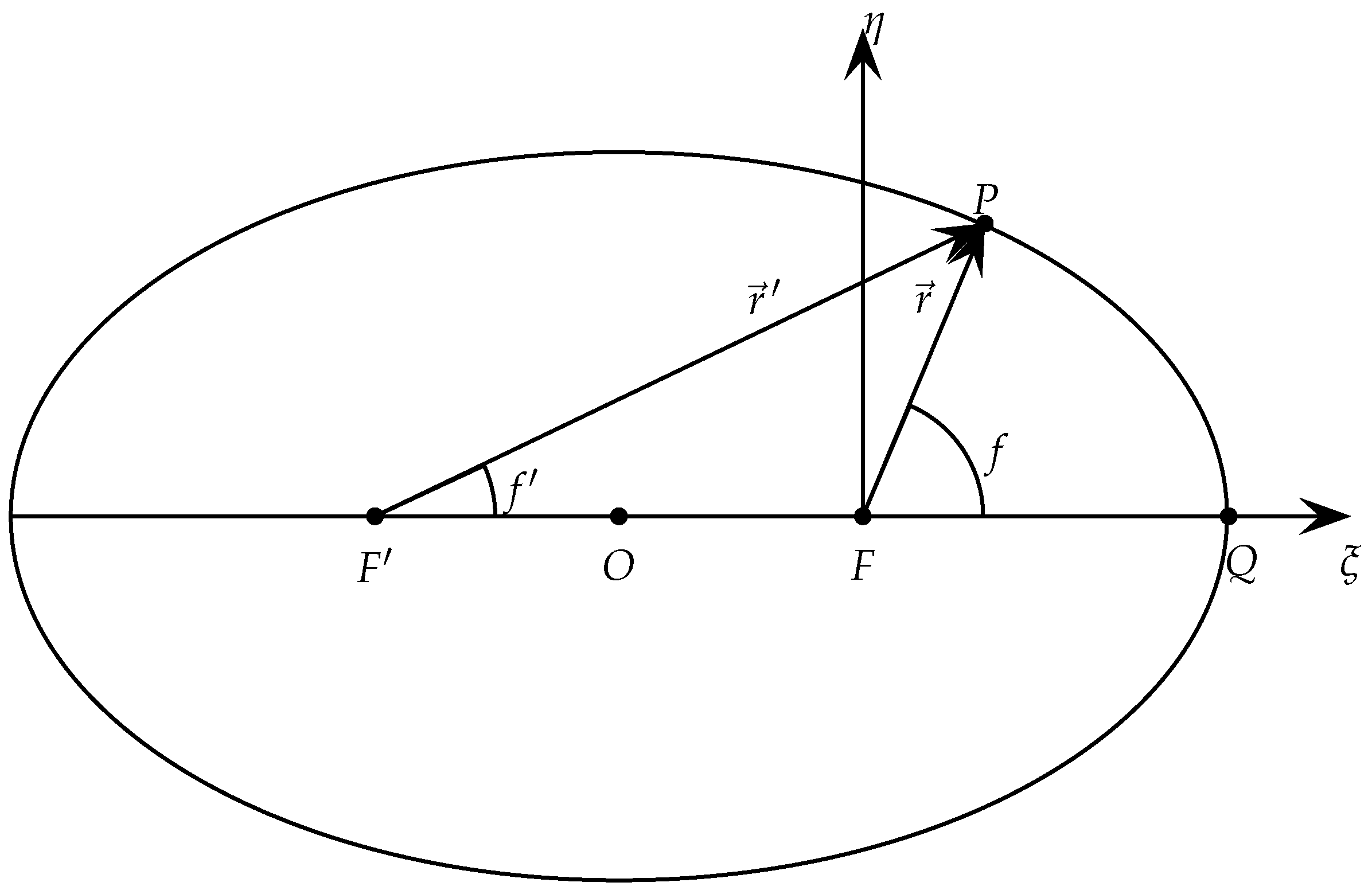
Figure 2.
Parametric u, geodetic and geocentric latitudes.
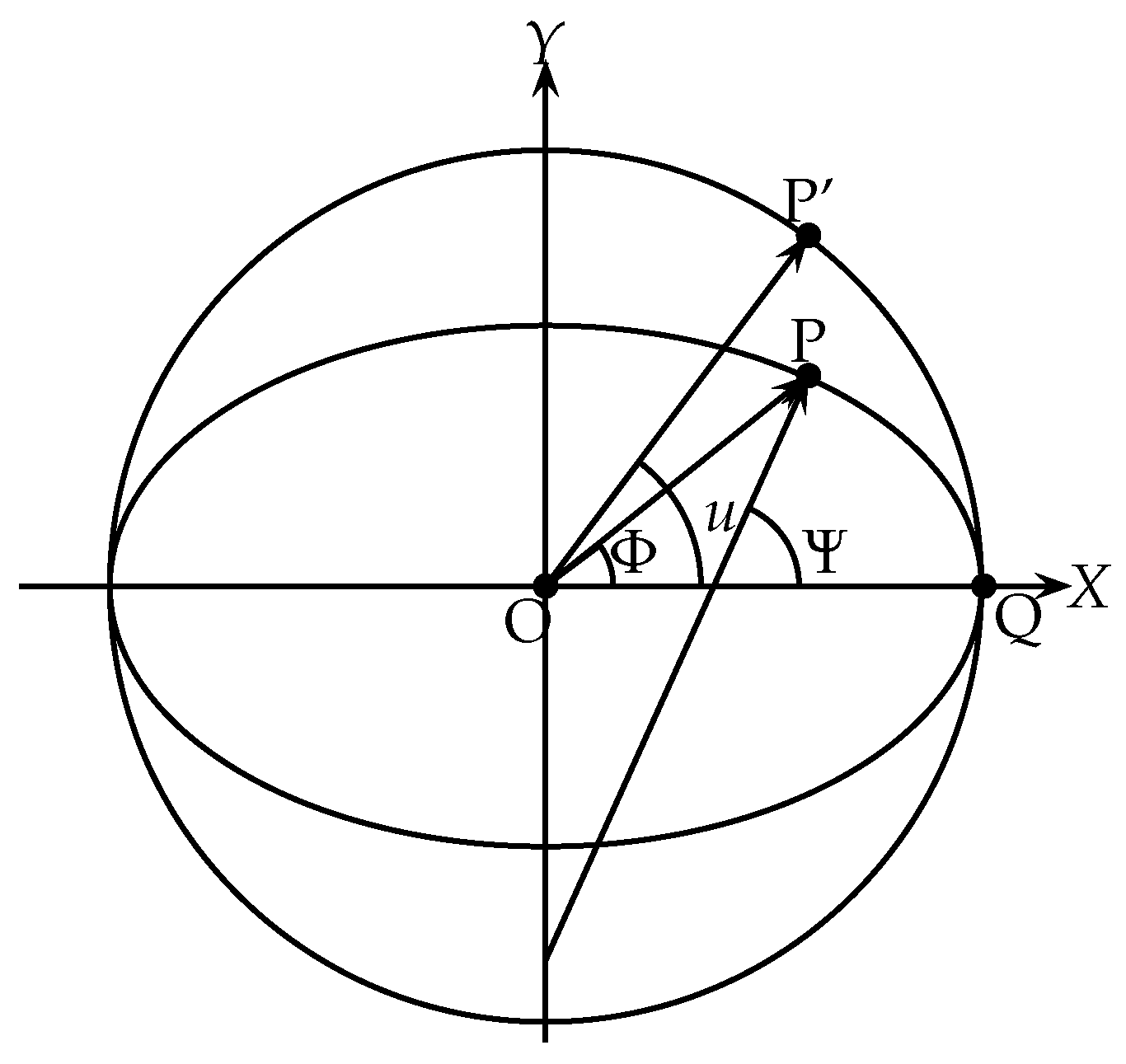
Figure 3.
Relation between semifocal and geodetic anomaly.
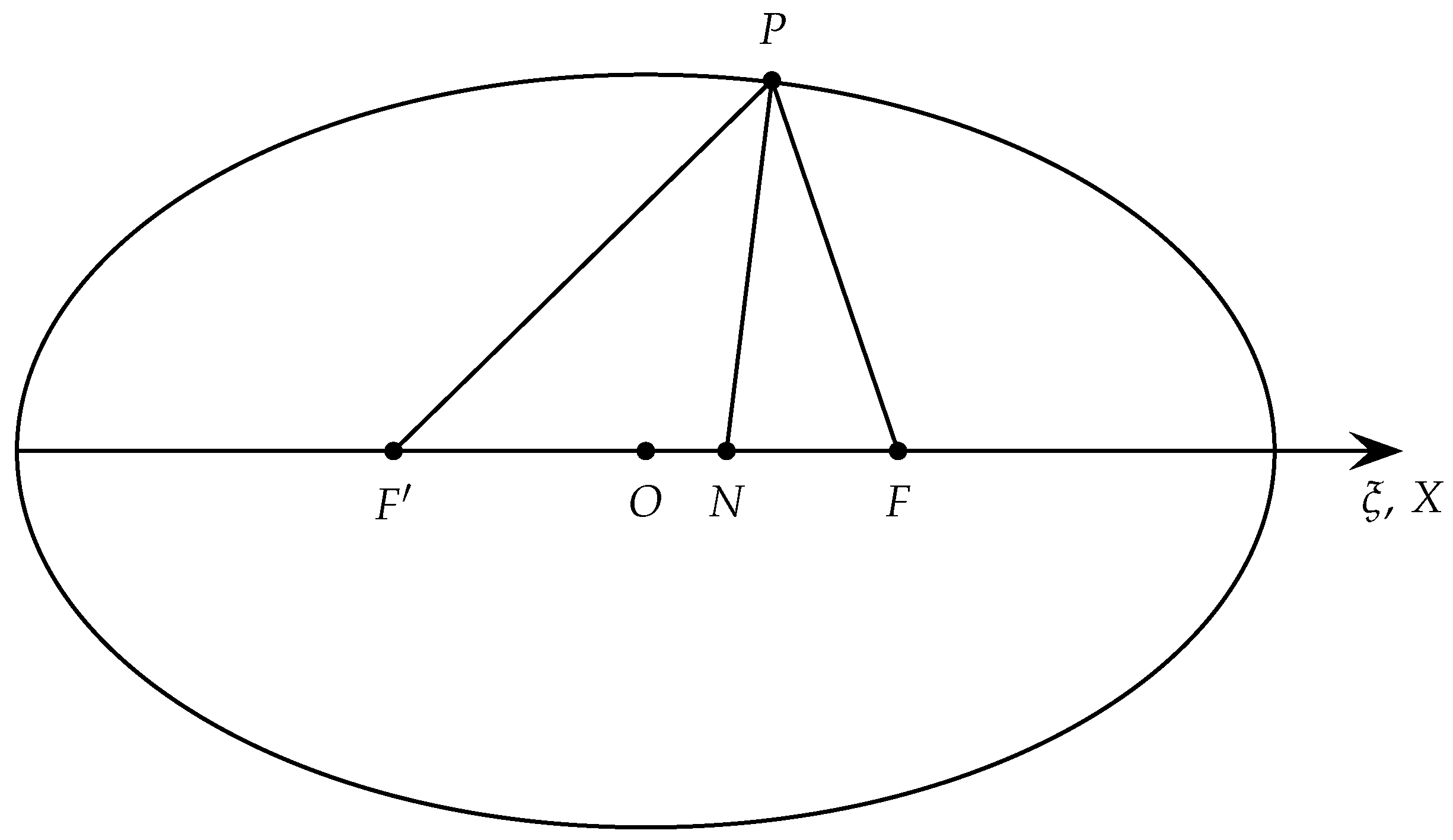
Figure 4.
Points distribution for , , .
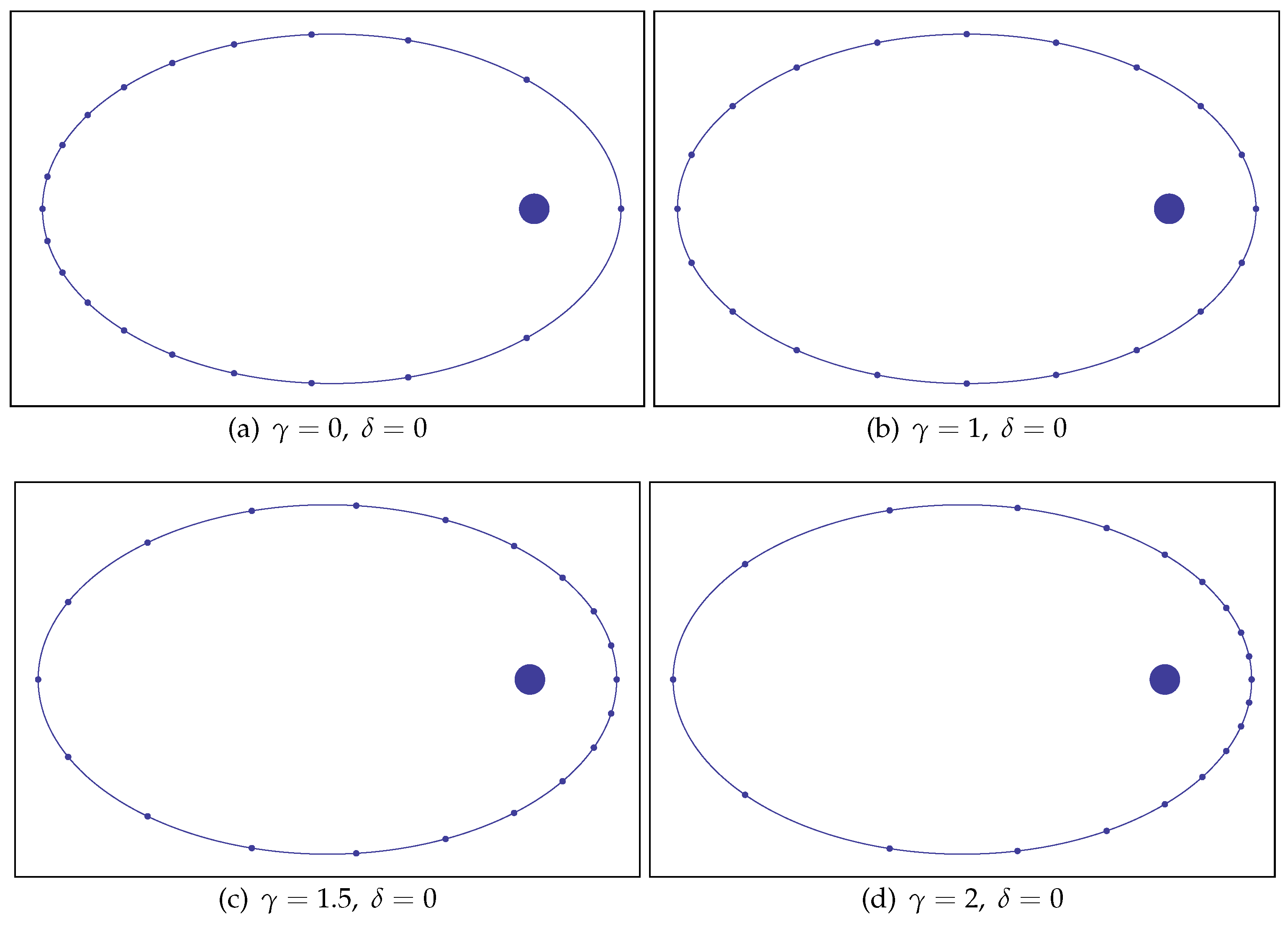
Figure 5.
Points distribution for , g, s, w, .
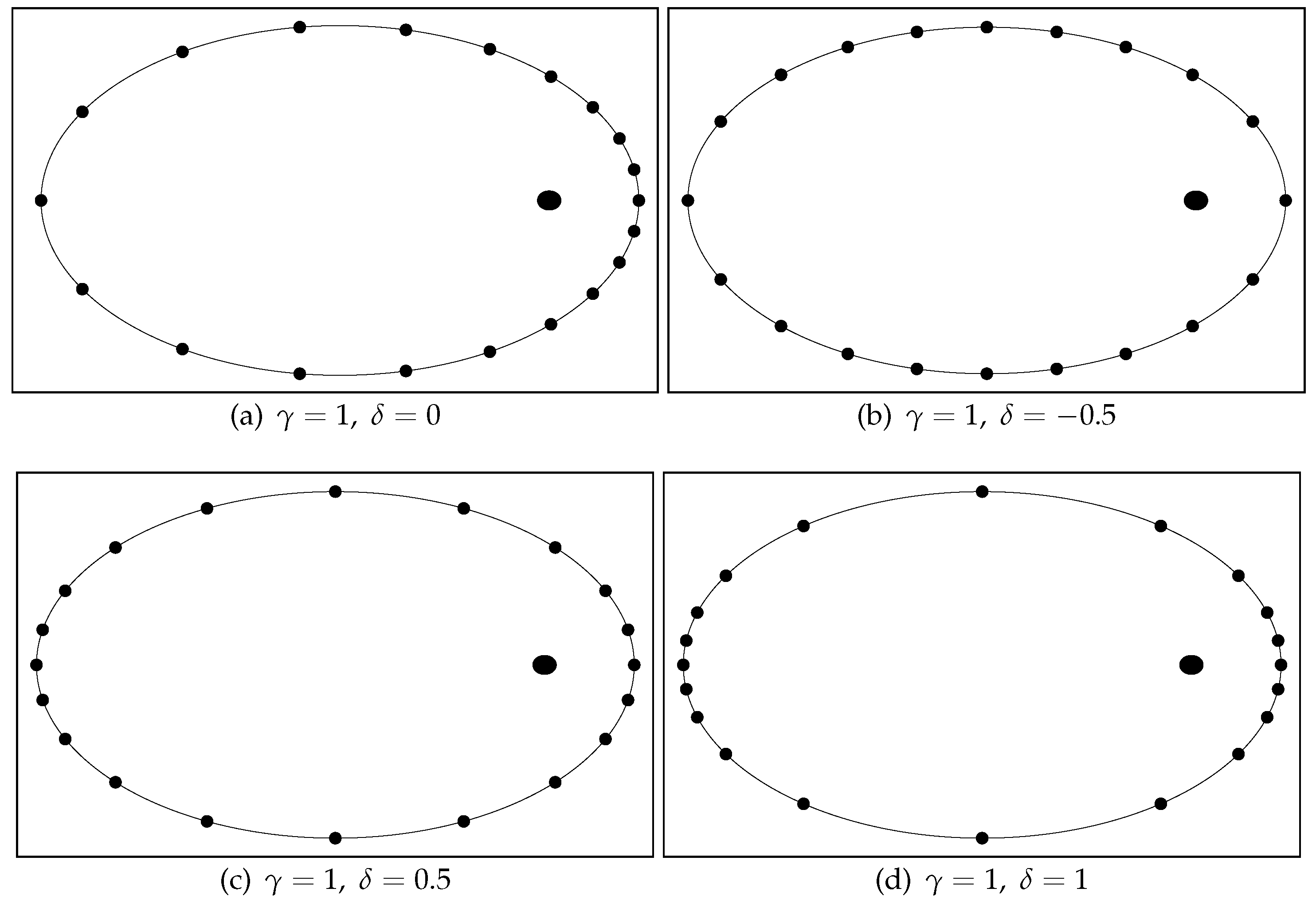
Figure 6.
Points distribution for , g big black points, small red points.
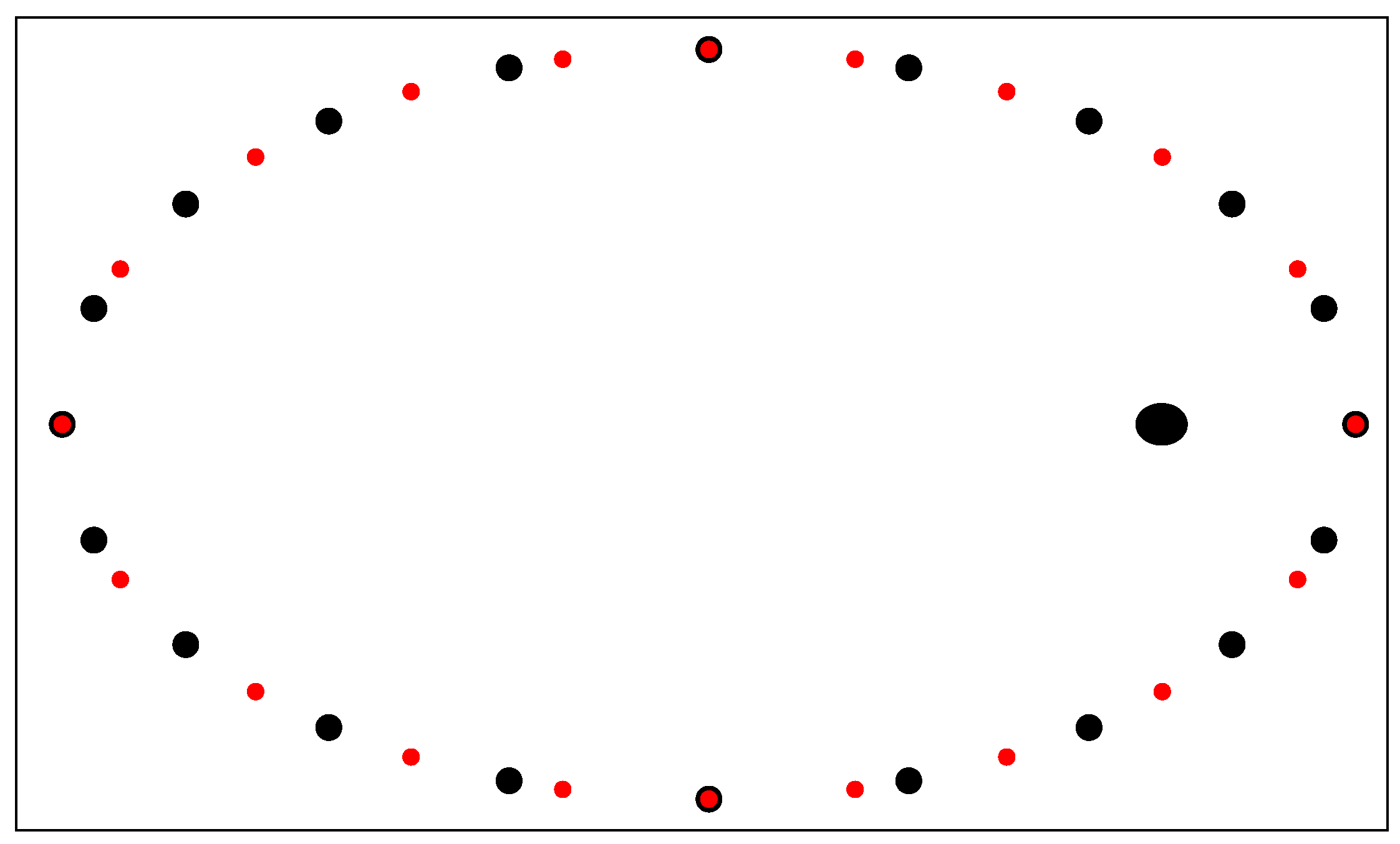
Table 1.
Integration errors in position and velocity for several values of and and its corresponding values in the biparametric family for the satellite Heos II.
Table 1.
Integration errors in position and velocity for several values of and and its corresponding values in the biparametric family for the satellite Heos II.
| M | g | f | w | |||||
|---|---|---|---|---|---|---|---|---|
| 0 | 1 | 2 | 1.5 | 0.5 | 1.5 | 1 | 2 | |
| 0 | 0 | 0 | 0 | -0.5 | 0.5 | 1 | 1 | |
| 9.54e00 | 1,12e-5 | 9.49e-10 | 2.86e-08 | 4.51e-4 | 1.07e-07 | 2.60e00 | 8.03e-06 | |
| 7.71e-3 | 9.01e-9 | 3.56e-11 | 2.41e-11 | 3.64e-7 | 4.41e-11 | 2.10e-3 | 6.51e-09 | |
| 0 | 1 | 2 | 1.5 | 1 | 1 | 0 | 1 | |
| 0 | 0 | 0 | 0 | -0.5 | 0.5 | 1 | 1 |
Disclaimer/Publisher’s Note: The statements, opinions and data contained in all publications are solely those of the individual author(s) and contributor(s) and not of MDPI and/or the editor(s). MDPI and/or the editor(s) disclaim responsibility for any injury to people or property resulting from any ideas, methods, instructions or products referred to in the content. |
© 2024 by the authors. Licensee MDPI, Basel, Switzerland. This article is an open access article distributed under the terms and conditions of the Creative Commons Attribution (CC BY) license (https://creativecommons.org/licenses/by/4.0/).
Copyright: This open access article is published under a Creative Commons CC BY 4.0 license, which permit the free download, distribution, and reuse, provided that the author and preprint are cited in any reuse.
MDPI Initiatives
Important Links
© 2024 MDPI (Basel, Switzerland) unless otherwise stated






